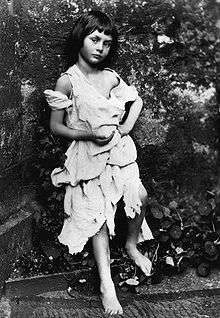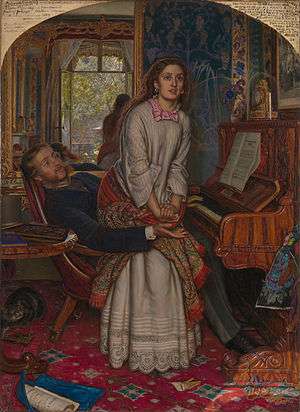Victorian morality

Victorian morality is a distillation of the moral views of people living at the time of Queen Victoria's reign (1837–1901) and of the moral climate of the United Kingdom of the 19th century in general, which contrasted greatly with the morality of the previous Georgian period. Many of these values spread throughout the British Empire. Today, the term "Victorian morality" can describe any set of values that espouse sexual restraint, low tolerance of crime and a strict social code of conduct.
The term "Victorian" was first used during the Great Exhibition in London (1851), where Victorian inventions and morals were shown to the world.[1] Victorian values were developed in all facets of Victorian living. The morality and values of the period can be classed as Religion, Morality, Elitism, Industrialism, and Improvement. These values took root in Victorian morality, creating an overall change in the British Empire.
Historians now regard the Victorian era as a time of many contradictions, such as the widespread cultivation of an outward appearance of dignity and restraint together with the prevalence of social phenomena such as prostitution and child labour. A plethora of social movements arose from attempts to improve the prevailing harsh living conditions for many under a rigid class system.
Historical background
The term Victorianum has acquired a range of connotations, including that of a particularly strict set of moral standards and rules often hypocritically applied. This stems from the image of Queen Victoria—and her husband, Prince Albert.[2]
Two hundred years earlier the Puritan movement, which led to the installment of Oliver Cromwell, had temporarily overthrown the British monarchy. Cromwell imposed a strict moral code on the people (such as abolishing Christmas as too indulgent of the sensual pleasures).
When the monarchy was restored, a period of loose living and debauchery inspired too by the rise of French court cultural influence all over Europe, appeared to be a reaction to the earlier religious based forms of repression. (See: Charles II of England) The two social forces of Puritanism and libertinism continued to motivate the collective psyche of Great Britain from the Restoration onward. This was particularly significant in the public perceptions of the later Hanoverian monarchs who immediately preceded Queen Victoria. For instance, her uncle George IV was commonly perceived as a pleasure-seeking playboy, whose conduct in office was the cause of much scandal.
Description

Historians Peter Gay and Michael Mason both point out that modern society often confuses Victorian etiquette for a lack of knowledge. It is often thought that those going for a swim in the sea at the beach would use a bathing machine out of modesty. Despite the existence of the bathing machine, it was still possible to see people bathing nude. Another example of the gap between common preconceptions of Victorian sexuality and historical record is that, contrary to what might be expected, Queen Victoria liked to draw and collect male nude figure drawings and even gave one to her husband as a present.[3] Popular conception suggests that typical middle-class brides likely knew nothing about sex and learned about their husbands' expectations for it on their wedding night, and that the experience was often traumatic. However, Victorian society did recognize that both men and women could enjoy copulation.[4]
Verbal or written communication of emotion or sexual feelings was also often proscribed so people instead used the language of flowers. However, they also wrote explicit erotica, perhaps the most famous being the racy tell-all My Secret Life by the pseudonym Walter (allegedly Henry Spencer Ashbee), and the magazine The Pearl, which was published for several years and reprinted as a paperback book in the 1960s. Victorian erotica also survives in private letters archived in museums and even in a study of women's orgasms. Some current historians now believe that the myth of Victorian repression can be traced back to early twentieth-century views, such as those of Lytton Strachey, a member of the Bloomsbury Group, who wrote Eminent Victorians.
Victoria ascended to the throne in 1837, only four years after the abolition of slavery in the British Empire. The anti-slavery movement had campaigned for years to achieve the ban, succeeding with a partial abolition in 1807 and the full ban on slave trade, but not slave ownership, which only happened in 1833. It took so long because the anti-slavery morality was pitted against powerful economic interests which claimed their businesses would be destroyed if they were not permitted to exploit slave labor. Eventually, plantation owners in the Caribbean received £20 million in compensation.
In Victoria's time, the Royal Navy patrolled the Atlantic Ocean, stopping any ships that it suspected of trading African slaves to the Americas and freeing any slaves found. The British had set up a Crown Colony in West Africa—Sierra Leone—and transported freed slaves there. Freed slaves from Nova Scotia founded and named the capital of Sierra Leone "Freetown". Many people living at that time argued that the living conditions of workers in English factories seemed worse than those endured by some slaves.
Throughout the Victorian Era, homosexuality held a vexed position in the culture. Homosexual acts were a capital offence until 1861. Michel Foucault has argued that homosexual and heterosexual identities didn't emerge until the 19th century; before that time terms described practices and not identity. Foucault cites "Westphal's famous article of 1870 on 'contrary sexual sensations'" as the "date of birth" of the categorization of the homosexual (Foucault 1976). The first known use of homosexual in English is not until Charles Gilbert Chaddock's 1895 translation of Richard von Krafft-Ebing's Psychopathia Sexualis, a study on sexual practices.[5]
In the same way, throughout the Victorian Era, movements for justice, freedom, and other strong moral values opposed greed, exploitation, and cynicism. The writings of Charles Dickens, in particular, observed and recorded these conditions. Karl Marx and Friedrich Engels carried out much of their analysis of capitalism in and as a reaction to Victorian Britain.
Religious morality

Religious morality changed drastically during the Victorian Era. When Victoria took the throne the Anglican Church was very powerful—running schools and universities, and with high ranking churchmen holding offices in the House of Lords.[6] The Church's power continued to rule in rural areas throughout the Victorian Era; however that was not the case in industrialized cities.[6] In the cities those against the Church were many and dissent was rampant.[6] However, dissent has been running its pressure since the onset of Puritanism in politics even before the Oliver Cromwell days. The dissenting sects were against what the Anglican church was using its power for.[7] The Church demanded obedience to God, submissiveness and resignation with the goal of making people more malleable to the will of the Church.[7] The Church was accused of appeasing the will of the elite, and of caring little if at all about the needs and wants of the lower, peasant class,[7] from which dissent emerged Methodism, Congregationalism, The Society of Friends (Quakers) and Presbyterianism.[7] The Methodists and Presbyterians in particular stressed personal salvation through direct individual faith in Jesus Christ's sacrificial death and resurrection on the behalf of sinners, citing the New Testament Gospels and the writings of the Apostles Peter, James and Paul.[7] This stress on individualism is seen throughout the Victorian Era and becomes even more developed in Middle Class life.
The Crisis of Faith was brought about in 1859 with Charles Darwin's work On the Origin of Species; his theory was (in the basic form) that the Natural World had become what it was through gradual change over eons.[8] He stated that natural selection and survival of the fittest were the reasons man had survived so long.[8] His theory of evolution based on empirical evidence would call into question Christian beliefs and Victorian values.[9] People whose lives became totally uprooted felt the need to find a new system on which to base their values and morality.[9] Unable to completely lose faith, they combined both their religious beliefs with individual duty—duty to one's God, fellow man, social class, neighbour, the poor and the ill.[9]
The elite and middle class values

At the start of the Victorian era, the elite were in total control of society and its politics.[10] The elite were made up of about 300 families which were firmly established as the traditional ruling class.[11] However, new values, such as individualism, were developing throughout the Victorian era. For example, the idea of the self-made man[12] became a dominant aspiration in the middle class. Similar to the American Dream, the idea is that, if they work hard enough, all men can become wealthy.
Upper class values
The upper class (the elite) valued history, heritage, lineage and the continuity of their family line.[13] They believed that they were born to rule through divine right and they wanted this right to continue.[13] They had a paternalistic view of society, seeing themselves as the father in the family of society.[13] Noblesse oblige was their belief that it was the elite's duty to take care of society.[13] The elite hoped to continue tradition and the status quo, through institutions such as the law of primogeniture (first-born son inherits everything).[13] The elite intended to stay on top and wealthy.[13] However, when a financial crisis threatened their position, they adapted and opened up their ranks to the wealthiest of the middle class, allowing them to buy a place within the ranks of the elite.[13] The elite were landed gentry and so they did not have to work, and instead enjoyed a life of luxury and leisure.[13] While the elite maintained their traditional values, Victorian values and attitudes changed and the elite began to recognize and promote the middle class.
References
- Notes
- ↑ Merriman 2004,p. 749.
- ↑ Merriman 2004, p. 747.
- ↑ Peter Gay, The Bourgeois Experience: Victoria to Freud
- ↑ Draznin, Yaffa Claire (2001). Victorian London's Middle-Class Housewife: What She Did All Day (#179). Contributions in Women's Studies. Westport, Connecticut: Greenwood Press. pp. 95–96. ISBN 0-313-31399-7.
- ↑ David Halperin, One Hundred Years of Gayness , Routledge, 1990, page 15
- 1 2 3 Bayley, S. 2008, p. 108
- 1 2 3 4 5 Bayley, S. 2008, p. 109
- 1 2 Bayley, S. 2008, p. 112
- 1 2 3 Bayley, S. 2008, p. 113
- ↑ Bayley, S. 2008, p. 146
- ↑ Bayley, S. 2008, p. 147
- ↑ Bayley, S. 2008, p. 200
- 1 2 3 4 5 6 7 8 Bayley, S. 2008, p. 154
- Bibliography
- Bayley, S (2008). Victorian Values: An Introduction Montreal: Dawson College.
- Gay, Peter. The Bourgeois Experience: Victoria to Freud
- Merriman, J (2004). A History of Modern Europe; From the French Revolution to the Present New York, London: W.W. Norton & Company.